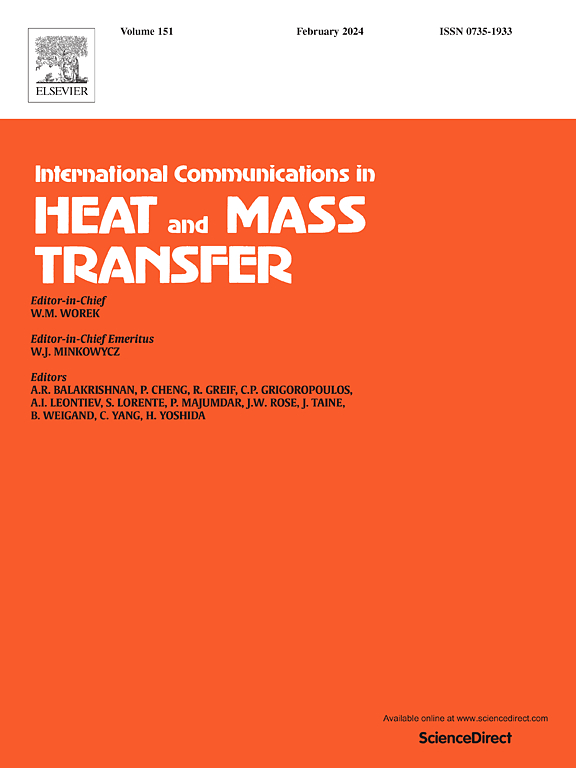Parametric study for thermal uniformity analysis on vertical fin located in novel designed impacting-jet double-layer nested microchannel heat sinks verified by SLM 3D printing method
IF 6.4
2区 工程技术
Q1 MECHANICS
International Communications in Heat and Mass Transfer
Pub Date : 2024-11-13
DOI:10.1016/j.icheatmasstransfer.2024.108321
引用次数: 0
Abstract
The design of impacting-jet double-layer nested microchannel heat sinks (IJDN-MHS) has been proved to be an effective structure on heat dissipation improvement in electronic components. In order to achieve ideal substrate thermal uniformity for IJDN-MHS, the position research on vertical fin connecting inner/outer cooling circuit in IJDN-MHS has been studied numerically. Moreover, 3D printing test samples are made on the purpose of experimental verification using selective laser melting printing technology. As a result of the analysis, there is a strong correlation between the results of the numerical simulation and the experimental results. Through numerical simulation, it has been determined that the center fin position should be optimized for achieving the best thermal uniformity on the substrate. The model of distance between vertical fin connecting inner/outer cooling circuit and central point in IJDM-MHS equaling 0.27 mm (IJDN-MHS_0.27) has shown the optimal thermal symmetry on substrate. Further, with the streaming fins length increasing to 0.7 mm on the both sides of the vertical fin connecting inner/outer cooling circuit, thermal gradient at the bottom can be significantly controlled, and the peak temperature on substrate also drop to its most extreme limit based on the thermal uniformity on substrate.
利用 SLM 3D 打印方法验证新型设计的冲击喷射式双层嵌套微通道散热器中垂直鳍片热均匀性的参数研究
冲击喷射双层嵌套微通道散热器(IJDN-MHS)的设计已被证明是改善电子元件散热的有效结构。为了使 IJDN-MHS 达到理想的基片热均匀性,对 IJDN-MHS 中连接内/外冷却回路的垂直鳍片的位置进行了数值研究。此外,还利用选择性激光熔融打印技术制作了 3D 打印测试样品,以进行实验验证。分析结果表明,数值模拟结果与实验结果之间存在很强的相关性。通过数值模拟,确定应优化中心鳍片位置,以实现基底上最佳的热均匀性。IJDM-MHS 中连接内/外冷却回路的垂直鳍片与中心点之间的距离等于 0.27 毫米(IJDN-MHS_0.27)的模型显示了基板上最佳的热对称性。此外,随着连接内/外冷却回路的垂直鳍片两侧的流鳍长度增加到 0.7 毫米,底部的热梯度可得到显著控制,基板上的峰值温度也在基板热均匀性的基础上降至最极端极限。
本文章由计算机程序翻译,如有差异,请以英文原文为准。
求助全文
约1分钟内获得全文
求助全文
来源期刊
CiteScore
11.00
自引率
10.00%
发文量
648
审稿时长
32 days
期刊介绍:
International Communications in Heat and Mass Transfer serves as a world forum for the rapid dissemination of new ideas, new measurement techniques, preliminary findings of ongoing investigations, discussions, and criticisms in the field of heat and mass transfer. Two types of manuscript will be considered for publication: communications (short reports of new work or discussions of work which has already been published) and summaries (abstracts of reports, theses or manuscripts which are too long for publication in full). Together with its companion publication, International Journal of Heat and Mass Transfer, with which it shares the same Board of Editors, this journal is read by research workers and engineers throughout the world.

 求助内容:
求助内容: 应助结果提醒方式:
应助结果提醒方式:


